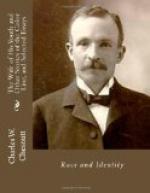Miss Alice Clayton was queen of her social set. She was young, she was handsome. She was nearly white; she frankly confessed her sorrow that she was not entirely so. She was accomplished and amiable, dressed in good taste, and had for her father by all odds the richest colored man—the term is used with apologies to Mr. Clayton, explaining that it does not necessarily mean a negro—in Groveland. So pronounced was her superiority that really she had but one social rival worthy of the name,—Miss Lura Watkins, whose father kept a prosperous livery stable and lived in almost as good style as the Claytons. Miss Watkins, while good-looking enough, was not so young nor quite so white as Miss Clayton. She was popular, however, among their mutual acquaintances, and there was a good-natured race between the two as to which should make the first and best marriage.
Marriages among Miss Clayton’s set were serious affairs. Of course marriage is always a serious matter, whether it be a success or a failure, and there are those who believe that any marriage is better than no marriage. But among Miss Clayton’s friends and associates matrimony took on an added seriousness because of the very narrow limits within which it could take place. Miss Clayton and her friends, by reason of their assumed superiority to black people, or perhaps as much by reason of a somewhat morbid shrinking from the curiosity manifested toward married people of strongly contrasting colors, would not marry black men, and except in rare instances white men would not marry them. They were therefore restricted for a choice to the young men of their own complexion. But these, unfortunately for the girls, had a wider choice. In any State where the laws permit freedom of the marriage contract, a man, by virtue of his sex, can find a wife of whatever complexion he prefers; of course he must not always ask too much in other respects, for most women like to better their social position when they marry. To the number thus lost by “going on the other side,” as the phrase went, add the worthless contingent whom no self-respecting woman would marry, and the choice was still further restricted; so that it had become fashionable, when the supply of eligible men ran short, for those of Miss Clayton’s set who could afford it to go traveling, ostensibly for pleasure, but with the serious hope that they might meet their fate away from home.
Miss Clayton had perhaps a larger option than any of her associates. Among such men as there were she could have taken her choice. Her beauty, her position, her accomplishments, her father’s wealth, all made her eminently desirable. But, on the other hand, the same things rendered her more difficult to reach, and harder to please. To get access to her heart, too, it was necessary to run the gauntlet of her parents, which, until she had reached the age of twenty-three, no one had succeeded in doing safely. Many had called, but none had been chosen.




